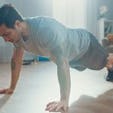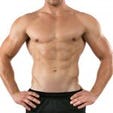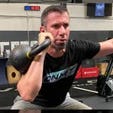Ah, to be young. If you’re under 30, you may be relishing your all-nighters, beer pong tourneys, and joint-smashing workouts, because you can withstand almost anything when you’re a young gun. But if you don’t slow down and prioritize your health, you may find yourself out of bullets before you’re 30.
Skateboarding pro Neen Williams recognized that after he tore his ACL at age 28—an event that saw him change his lifestyle overnight, and eventually find his way to Onnit. Now 36, he’s in the shape of his life, and plans to be a better sk8er at 80 than he is today. See how in his interview with John Wolf below—part of our ongoing Onnit Stories series, in which we feature live video of people who have made inspiring life changes with Onnit’s help.
Below the video is an edited transcript of the highlights. You can stay up to date with Onnit Stories by following Onnit’s Instagram TV (IGTV), where a new one appears every other Wednesday.
John Wolf: Please give a little background on yourself for those who don’t know.
Neen Williams: I’m a professional skateboarder and an Onnit pro. I’m also a coach for Ladder, an online fitness app, and I own a business. We make spices—special spice rubs. Me and my fiancé, we decided to build our own company to make meal prep delicious and easy, and so we’ve been running that for about two and a half years now. I’m all across the board grinding and just getting after it.
I’d love for you to talk about your journey through professional skateboarding and how your work led you to Onnit.
I grew up a skateboarder. I’m still a skateboarder and will be to the day that I die. I lived that skate life. I didn’t have a boss to answer to, a job to clock in for, or anything like that. Being a street skateboarder, you basically create your career by just filming tricks and making videos. It’s almost like making mixtapes and then putting out your creation at the end of a few months or a year and letting people see all the tricks that you did. That’s the kind of skateboarding I do.
Nowadays, there’s other skateboarding, which is like the stuff you see on TV—Street League, and stuff like that. Those are the more contest-style skateboarders. But I’m a professional street skater. We just work on our own time. We’re in charge of what we do. We’re like street artists, and with that comes a carefree life. My peers and my friends, we were always just drinking, partying, skating. That’s what we did because we didn’t have to wake up at any particular time, and we didn’t have to go to sleep at any particular time. There was no structure.
Later on in my life, I realized I had to slow down on all of that because I was feeling a lot worse every single day. I was dealing with hangovers that went for two days when I was younger to five days when I was older. I was getting injured because I wasn’t on my game.
I started getting into the whole health and fitness side of life, and taking supplements, and just figuring out things that can help me be the best that I can be. That’s how I found all you guys at Onnit. I found Onnit and started buying the whey protein, the Alpha BRAIN®, stuff like that. A couple of my friends knew some of the employees, so they connected me with you guys, and one thing led to another. We’ve had a lovely partnership for a few years now.
So you were at a point where you wanted to level up, and you knew you needed resources to help you do that?
Well, basically, what happened was I tore my ACL. It was my other ACL—I had already torn my right one when I was 22. I tore my second ACL at 28. I was getting older, especially for a skateboarder, so I had to ask myself, “Is this party lifestyle really worth me losing my career? How can I turn this around and really get everything out of my career that I can?”
I told myself I was going to quit drinking and go to physical therapy, and, with those changes, I didn’t really have anything else to do anymore. I was used to a high output—skating all day, I’d burn around 4,000 calories. At least that’s what my Whoop tracker says. But all of a sudden, I was just doing physical therapy and I wasn’t going out to party anymore, so I needed something to help me burn off extra energy.
I started doing upper-body workouts so I could blow off steam, and, slowly adopting everything else that comes with the workout lifestyle, I was on a new journey.
I think such a big part of your creative output, your art as a street skateboarder, is testing the end ranges of things—the limits of what a human being can do. It seems like you’d almost have to hit that wall in order to know where to pull back. For you, it was an injury. But we all eventually have that moment that shifts our perspective and we realize that what we’re doing isn’t working anymore.
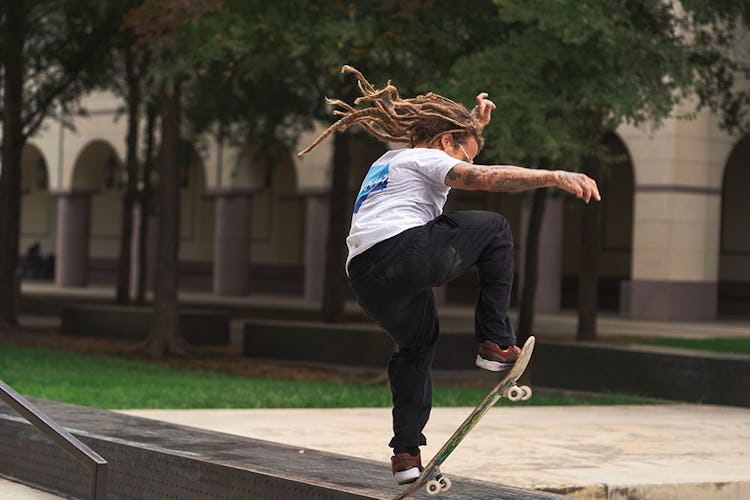
Yeah, man. It’s a crazy journey, and it’s crazy that it has to work that way. But, I swear, that’s how you find it. And that’s how it really resonates and sticks with you as well. You have to experience something really challenging to be like, “Oh, wow, I need to change things up to continue doing what I love at the level that I want to perform at.”
So you were 28 at the time. How old is 28 in the world of pro skateboarding?
Well, it’s nearing the older ages, because skateboarding is pretty much a young sport. Kids start it at two or three years old nowadays—as soon as they’re able to walk. But we have a lot of older skateboarders that are still around, and they’re an asset to skateboarding. The truth is, there’s no age in skateboarding. You could pretty much skate whenever you like to skate, no matter how old you are. But when it comes down to the industry, and skating professionally, you have to be doing something if you want to keep going.
For myself, throughout all my injuries and reconstruction surgeries and stuff, training and taking care of myself has been the number one thing. That’s been the driving force that keeps me solid and able to keep performing the way that I want to perform.
As an athlete and a coach, what forms of training resonate with you the most? What have you found to be really impactful for you to stay in the game and continue to perform?
What I’m training for is to skate. So I’m training appropriately for the thing that I’m doing. I’m training like an athlete—doing some strength training, some plyometrics, working on stamina, and strengthening weak areas like core, glutes, and hamstrings. These are all things I need when I’m on a skateboard. I’m not trying to annihilate muscle groups to gain size, just stimulate them and keep mobile and agile.
People send me messages, DMs and stuff, and they’re like, “Isn’t skateboarding enough of a workout?” And I’m like, “It’s good cardio, and yeah, there’s some legs and some core involved,” but at the same time, it’s repetitive and it beats you down. You have to work on maintaining your body to avoid injuries down the road.
Yeah, I think that’s a common perspective. “Oh, I don’t work out, I just do X or Y, and that keeps me in shape.” What you do might be a good cardiovascular workout, but is it training? Is it preparing you to do your activity better and allowing you adequate recovery from that activity? I remember the first time you and I hung out, I showed you this crazy foam roller routine I was working on.
And I’ve been using that. I use that every day. That’s my go-to. When I wake up, I set aside 20 minutes, get my coffee, and I just go to town on the foam roller and get my movement prep going. That’s how I loosen everything up from sleeping. I always say, regardless of what you do, it’s important to go over a foam rolling and stretch routine before you start your day. When you sleep, you’re all cuddled up into a little ball—your spine’s twisted. If you wake up and you do that foam rolling routine, and then do some movement prep like Onnit Academy teaches, you help reduce the risk of injuries.
I look up to people like you guys. You’ve taught me so much. I’ve gotten certified in kettlebells and the steel mace and it’s opened up a whole new world. I’ve learned that recovery is just as important as training. That’s how you avoid those overuse injuries.
Is there a particular unconventional tool that resonates with you?
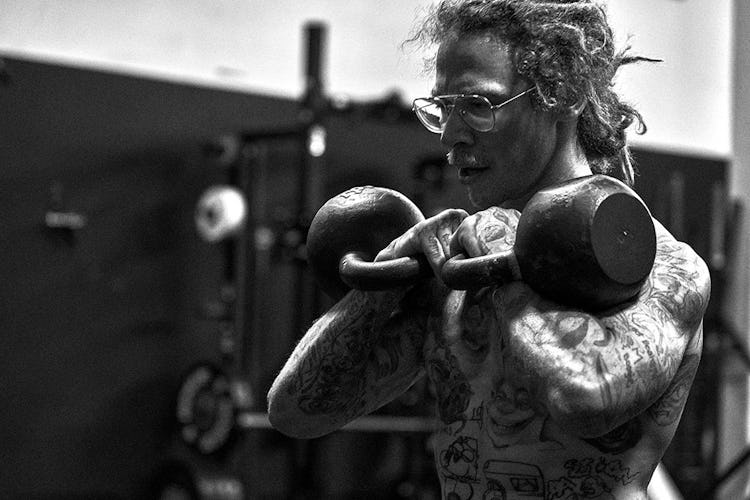
I love the kettlebell. Whenever I travel, I usually bring one kettlebell just under the max weight limit of the luggage so I don’t get charged extra [laughs], and I bring my exercise bands. Then I’ll go to the gym in the hotel and I won’t use anything else they have—just my one kettlebell and my bands.
I think kettlebell training reflects skateboarding so well. It’s cardio, it’s full-body, it’s very explosive. You’re using your hips a lot, your glutes, your hamstrings, and your core. So it’s basically mimicking what you do with a skateboard.
Yes, there are so many different ways we can use a kettlebell. In the Onnit system, we use it to take advantage of all the different planes of motion. We start with the fundamental movements, and then we can progress to complexes, where you might do a couple different movements in a row, and then to flows, which are a fluid collection of movements. Do you explore anything like that in your training?
Yeah, that’s a great point. Skateboarding is not just straight ahead, so you can’t just do squats and deadlifts to train for it. We land every which way, sometimes with our knee turned in. So you have to strengthen your body in all ways, 360 degrees. I work on every single awkward position. You need to strengthen yourself in that way.
So, back to your question, yeah, I’ve used every single way possible, and I use the ones you listed daily. Sometimes I use the kettlebells for strength work, and I’m just working in one single plane. Sometimes I’m doing rotational work. Other times I mix it all into one workout for the day. It’s a little bit of this, a little bit of that, some single-arm stuff and double-arm stuff. And I love using isometrics. I’ll do a split-stance squat and hold the bottom position 30 seconds.
Have there been any other Onnit products that have been really impactful on your training, recovery, or any other aspect of your lifestyle?
Alpha BRAIN® is one of my tops. It just gives me clarity, gives me focus. Like I said earlier in this interview, I wear seven different hats and I run around all day. I’m busy, and I’ve got my phone, Instagram, social media—there’s all of this going on all at the same time. So Alpha BRAIN® helps me split everything up and focus on each thing 110% while I’m working on it. The Onnit Whey Protein is a favorite too. It’s delicious, smooth. Obviously, when you can’t make a meal every few hours, it’s easy to get protein in with that. Also, StronBONE®. I’m wrestling with the concrete, jumping down flights of stairs all day, so I need whatever bone support I can get. Whatever I can do to strengthen my ligaments, my tendons, my bones—I’m going to do it.
I know you’re big on your nutrition game and you have your line of spices. I’ve seen some pretty impressive protein meals come out of your kitchen. What’s your favorite cut of meat?
Probably a ribeye. It’s nice and fatty. It’s great for low-carb days when you need to eat higher fats. I also like a coulotte steak, which is like a roast with a big cap of fat on it. It’s so good. And I like tri-tip.
We’ve got a lot of questions from the viewers, so let’s jump in and start addressing some of these—because if we keep on talking about food, I’m going to go nuts. So here’s a question: “How do you balance working out and skating?”
Like I said before, I don’t beat myself up. I don’t try to annihilate the muscle. I don’t let myself feel super sore from workouts. Skateboarding is my priority, so I never train before I skate. I won’t train legs before I skate, because that would fatigue my legs, and then I couldn’t skate. But I can always skate before I train legs. So I go out, I skate first, get my tricks. Then I come home and I train at night.
Saturday and Sunday are my two favorite days to skate because businesses are closed, so people don’t freak out as much if you skate around their buildings. You can skate things that you’re not able to skate during the weekdays.
What other skaters and trainers inspire you?
Well, obviously, John Wolf right up here.
Oh, man. Don’t flatter me [laughs].
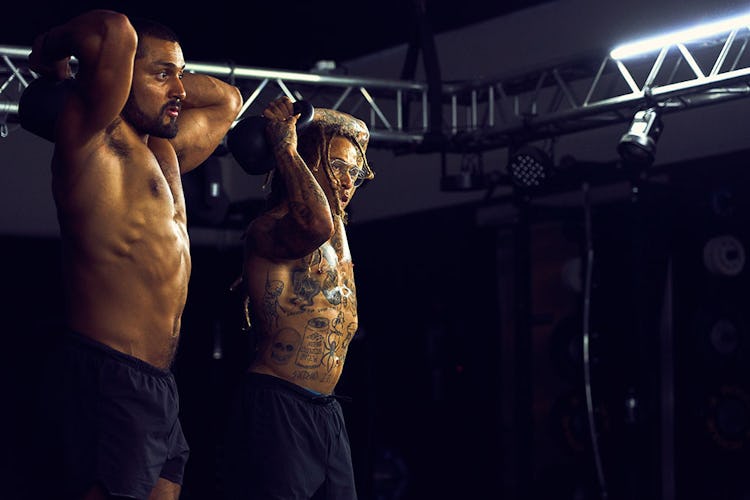
This is the guy. You’ve taught me so much about the body, mobility, and obviously, that foam rolling routine that you taught me a while ago. All of that stuff has taken me so far. Also, I’ve learned a lot from the Primal Swoledier, Eric Leija, and his brother, Juan. As far as skaters, there’s the boss, Andrew Reynolds. He’s one of my favorites. Bryan Herman has also been a favorite of mine for the longest time. There are so many. They are masters of their craft.
I’m honored to make that list, man. Here’s another question we got. You’re known as the heel flip king. What’s your favorite trick other than that?
I like rail tricks. I think just the good old front board is fun—back flips, back Smiths, back tails. Those are all some of my favorite tricks. When it comes to flip tricks, heel flips are probably number one. And then I would say maybe hard flips. Hard flips are really fun. I like how they feel.
Here’s a good one. “Hey, Neen, been a fan of yours since I was a teenager, and I grew up in that party skate culture. Have you had a lot of support from your peers since cleaning up your lifestyle? Or are you in a position where you feel you’ve had to be the positive force for your peers?”
At the beginning, when I first started on my health journey, I was getting backlash here and there from other skaters. But after a while, they understood what I was doing. I do all of this stuff to be able to skate. For years and years and years to come, I want to feel good on my board and skate the way that I want to skate. It’s almost been eight years now that I’ve been doing this, so people understand and other skaters understand it’s just what I do. So it’s become something cool and it’s become accepted.
I think it’s really great for younger skaters to have access to you and see how your lifestyle is enhancing your professional ability.
Something that people don’t really talk about much is the mental benefits of taking care of yourself. Fitness is very mentally pleasing, and it makes you feel way more positive during the day. That’s one of my favorite parts about it.
We’ve got a question here: “What’s Neen’s max plank time?”
I really don’t know. I’ve never really been into how much I can deadlift or squat. I’ve never really been the PR dude. I just want to be in this for the long run. So, my main focus is just being a little bit better each day. I don’t want to be my strongest next week; I want to be my strongest when I’m 80 years old, if I make it there.
I love that response. In our education system, I try to emphasize to people that I don’t really care how many reps you do; I only care how pretty the ones you do are. It’s quality over quantity, time, or weight. In skateboarding, to land a trick that looks like hell and just barely not die doing it is different than to land it safely and own it. If you’re doing an exercise, it’s the same thing: we want you to own that movement.
Speaking of tricks, when did you land your first heel flip?
I started skating at 13 or 14. I learned how to ollie, and then I did my first heel flip on the carpet. But I believe I did it switch, because I started skating in the winter in Chicago, and that goes on for months. So I had to skate inside, and I didn’t know which way to ride. Either you ride goofy, with your right foot forward, or you ride regular with your left foot forward. I was always doing tricks with my left foot, so I think I landed my first heel flip with a switch.
But I’ve never really been the person that skated a lot of switch skating. I always wanted to do the tricks that no one else was really doing. So that’s why I do a lot of heel flip tricks. No one was doing the heel flip down the gap. That’s how it’s always been—I just try to do tricks that I don’t really see many people do.
How are you enjoying skating in this wonderful Texas heat?
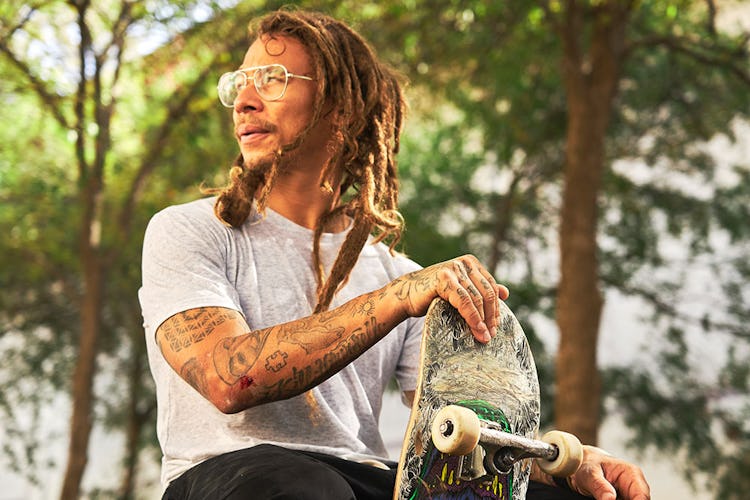
Yeah, so I moved to Texas. It’s been a year so far. I live in Fort Worth, 40 minutes or so from Dallas. Being a city kid, I’m used to being around buildings, but now I’m surrounded by trees, which I love. I’ve always had the dream of being sustainable with life—having some chickens that are laying eggs for me in the morning and growing plants I can eat, stuff like that. So, I’m getting to do that out here, which is awesome.
But the heat has made me switch up my schedule. I wake up later—I aim for 11:00, 12:00 in the afternoon—and I stay up later at night and start skating at like 4:00 or 5:00. I skate the last four hours of daylight and then go up to the skate park that’s lit up. Then I’ll go home and work out. So I’ll work out at 1:00 in the morning. But when the fall weather kicks in, I’ll start earlier.
This is from one of our community members who’s really active in our Onnit tribe. Anthony Mejia says, “As a fellow boarder, the challenges of changing friends and doing what’s best for us is hard. Do you do any outreach for kids to help promote a healthier lifestyle?”
Thanks for asking, Anthony. What I do is what you see mostly on my Instagram. If you watch my stories, a lot of them are just what I’m eating. How I cook certain things. I’ll throw in a stretch routine every now and then, or my workouts, and I give them all away for the most part. That’s how I try to help. I try my best to share as much as I can.
I’ll bounce back to a food question real quick. “Hey, Neen, if you could have one lunch meal every day for the rest of your life—a healthy one, of course—what would it be?”
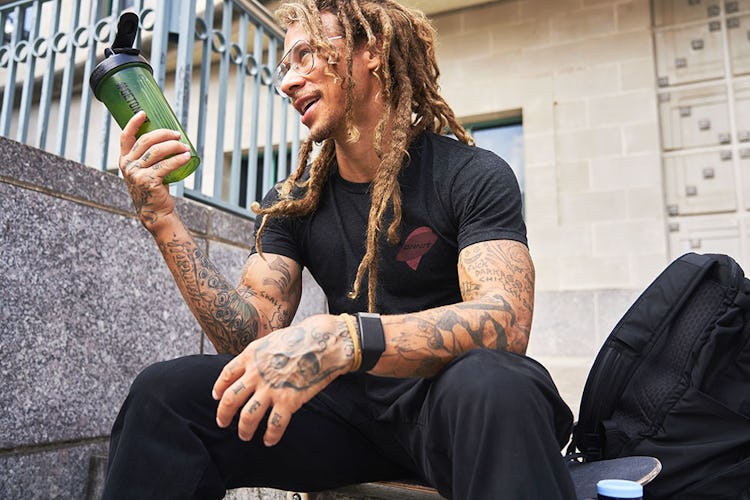
That one’s tough, because I like doing carb cycling. So some days my meals are low-carb, and some days they’re high carb. On a high-carb day, I would say a smoothie with two scoops of Onnit Vanilla Whey Protein in it. That’s one of my favorite treats. On a low-carb day, it would be another smoothie, for sure, because I don’t really eat lunch, per se. I mostly eat smoothies for lunch with scoops of protein.
Breakfast or non-breakfast tacos?
Always breakfast tacos. That’s all I eat. Every day I try to steer away from eating tortillas for breakfast, but I can’t help it. So I normally just go for the alternative, the almond flour tortillas. But I’ll switch it up, some days having flour tortillas. Whenever I come out to Austin, I go straight to Pueblo Viejo and I just get four breakfast tacos every time.
What’s your go-to cooking method for your ribeye?
I personally like to do a reverse sear. Slow and low at about 250 degrees—275 if you’re in a rush. But first, you want to leave the ribeye out on your table for like 45 minutes to two hours—usually two hours to get it really room temperature. Then throw it in that oven at 250 for about 20 or so minutes. You want an internal temp of about 118, 120 degrees. Then I pull it. Remember, it’s going to go up in temp about five degrees, so it’ll turn out perfect rare at 125 degrees. If you like it more cooked, then, obviously, leave it in longer. Then you just get some butter in a pan, get it super hot in a cast-iron skillet, and just sear it on both sides about 30 seconds or so. Just get a nice, crispy, crust on it, and then you can eat.
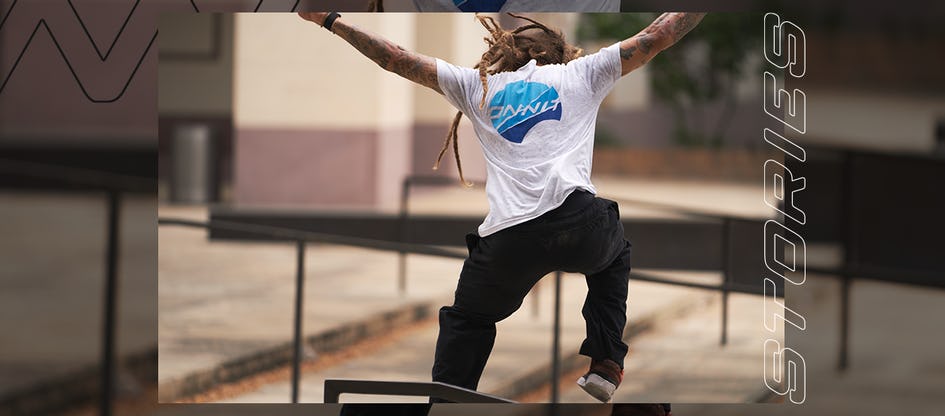
)
